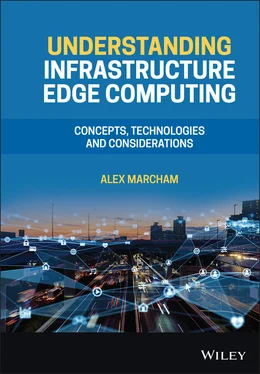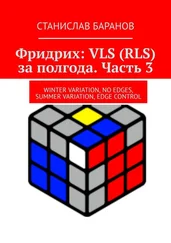Alex Marcham - Understanding Infrastructure Edge Computing
Здесь есть возможность читать онлайн «Alex Marcham - Understanding Infrastructure Edge Computing» — ознакомительный отрывок электронной книги совершенно бесплатно, а после прочтения отрывка купить полную версию. В некоторых случаях можно слушать аудио, скачать через торрент в формате fb2 и присутствует краткое содержание. Жанр: unrecognised, на английском языке. Описание произведения, (предисловие) а так же отзывы посетителей доступны на портале библиотеки ЛибКат.
- Название:Understanding Infrastructure Edge Computing
- Автор:
- Жанр:
- Год:неизвестен
- ISBN:нет данных
- Рейтинг книги:4 / 5. Голосов: 1
-
Избранное:Добавить в избранное
- Отзывы:
-
Ваша оценка:
- 80
- 1
- 2
- 3
- 4
- 5
Understanding Infrastructure Edge Computing: краткое содержание, описание и аннотация
Предлагаем к чтению аннотацию, описание, краткое содержание или предисловие (зависит от того, что написал сам автор книги «Understanding Infrastructure Edge Computing»). Если вы не нашли необходимую информацию о книге — напишите в комментариях, мы постараемся отыскать её.
Understanding Infrastructure Edge Computing
infrastructure edge computing
Understanding Infrastructure Edge Computing
Understanding Infrastructure Edge Computing — читать онлайн ознакомительный отрывок
Ниже представлен текст книги, разбитый по страницам. Система сохранения места последней прочитанной страницы, позволяет с удобством читать онлайн бесплатно книгу «Understanding Infrastructure Edge Computing», без необходимости каждый раз заново искать на чём Вы остановились. Поставьте закладку, и сможете в любой момент перейти на страницу, на которой закончили чтение.
Интервал:
Закладка:
Protocols operating at layer 2 are also responsible for providing link local addressing, a form of network endpoint identification where endpoint interfaces are given locally unique identifiers that enable intranetwork communication but which are not intended to be used as globally unique; this means that they are not suitable for use between networks but can uniquely identify endpoints on the same network. Through various means such as broadcast and multicast data transmission, these link local addresses are often used to allow an endpoint to discover the globally unique addresses of the endpoints it needs to communicate with, or at least that of the next hop in the path to get there.
3.3.3 Layer 3
Referred to as the network layer, layer 3 is the only layer of the OSI model which is responsible for internetwork addressing, where network endpoints can be assigned globally unique addresses. This is crucial as without this function, endpoints that are located in other networks would not be reachable and the internet (as a network of networks) would not be able to exist as it does today.
The globally unique addresses which layer 3 provides are mapped on to the link local addresses that are used by protocols operating at layer 2 by a process that is specific to each of those lower layer protocols. This ensures that when data sent from an endpoint on an external network targeted for an endpoint on the local network enters the local network, it can be correctly forwarded using its link local address (such as a MAC address in the case of Ethernet) as if that traffic had originated on the local network to begin with. The external network endpoint is unaware of this process entirely.
3.3.4 Layer 4
Layer 4 is named the transport layer. This label may seem odd, but it is for good reason: Above the means to transcode digital data into physical signals at layer 1, the MAC functions and link local addressing provided by layer 2, and the globally unique endpoint addressing capabilities enabled by layer 3, there is a need for a group of functions which determine how to send and receive data on the network at a layer of abstraction, which enables them to perform tasks such as flow control and integrity checking of any data received without reliance upon any specific set of layer 1, 2, or 3 technologies. This transport layer is the bridge between the application at higher layers of the stack and the underlying network technologies below, whatever they may be.
Two popular examples of layer 4 protocols are the Transmission Control Protocol (TCP) and the User Datagram Protocol (UDP). The primary difference between these two is that despite the fact that both protocols operate at the transport layer, TCP provides a guarantee that any traffic sent across the network will be delivered to its destination complete and in the order that it was sent. Comparably, UDP provides no such guarantee; data sent using UDP does not create any layer 4 acknowledgement from its destination that it was or was not received correctly. If a piece of data were lost in transit across the network and the application were using TCP, the receiver of the data would notify the sender and a retransmission would be arranged, whereas with UDP, it would just be lost. Although this may seem like a large drawback, whether it is or not depends on the use case; for real‐time applications such as video conferencing or Voice over Internet Protocol (VoIP) calls, it is beneficial to the user experience to allow a certain amount of lost data compared to incurring the delay of the sender having to retransmit any lost data, which can result in odd sound or video to an end user.
Although still very commonly used, the TCP and UDP protocols are not always the optimal choice. These protocols emerged in 1974 and 1980, respectively, and as such predate the applications that today generate the vast majority of traffic on the internet and its constituent networks, sometimes by several decades. Modern alternatives (such as the Stream Control Transmission Protocol [SCTP], which is designed to incorporate many of the desirable features of both TCP and UDP) are emerging and will see increasing use in the near future for use cases that require their additional capabilities such as native support for multihoming in the case of SCTP, where two endpoints may each have multiple globally unique addresses, allowing for the use of redundant network paths for added resiliency.
3.3.5 Layers 5, 6, and 7
These three layers are referred to as the session, presentation, and application layers, respectively. In practice their details are not encountered as much from the network perspective as they are by the inner workings of a specific application, which is why they are not going to be described in the same level of detail as the lower levels of the stack are in this chapter. As the functions at these layers are often handled within a single application at a single endpoint, the protocols at each of these upper layers as well as the interfaces between them tend to be less distinct than those at the lower layers where interoperation between endpoints from many sources is needed for the network to function.
As further degrees of interoperation between the network and the processing resources of the data centre both at the infrastructure edge and at the regional or national scale are used to support next generation use cases, the functions of these three upper layers of the OSI model will be increasingly used to provide that underlying network and data centre infrastructure with intelligence about the specific characteristics of the application in use, which will then be used to make nuanced decisions about how infrastructure resources can be allocated and used for optimal cost and user experience.
3.4 Ethernet
Ethernet is an example of a layer 2 protocol and is the most commonly used layer 2 protocol today. A basic understanding of some of the characteristics of Ethernet is useful in the context of infrastructure edge computing, as the protocol is so widely used both within the infrastructure edge data centre, as well as between them and between other facilities of both similar and larger scale.
Ethernet uses broadcast communication to perform network endpoint discovery. This means that when an Ethernet endpoint receives a frame with a destination MAC address and the endpoint does not have an existing entry in its switching table for that destination MAC address, a request is sent to all other Ethernet endpoints on that segment of the network, asking for the location of the endpoint which has that destination MAC address assigned to one of its interfaces. The protocol was designed in this way for implementation simplicity and low cost, both of which have helped Ethernet become established as the dominant layer 2 protocol today; but there is an equal drawback in regard to the inefficiency of this behaviour in a larger network, where the volume of broadcast traffic can be substantial enough to impact the performance of network endpoints and ultimately of the network.
The protocol is capable of supporting frame sizes between 64 and 1518 bytes as standard, and some equipment can be configured to support so‐called jumbo frames of up to 9600 bytes. The latter are useful for some use cases which rely on these jumbo frames in order to lower the overhead of large numbers of Ethernet frame headers involved when carrying data, or for protocols such as those of storage area networks (SANs), which natively use data segmentation sizes closer to a jumbo frame.
The most common type of traffic encountered on a modern network today is an Ethernet frame that encapsulates an Internet Protocol version 4 (IPv4) or Internet Protocol version 6 (IPv6) packet, using TCP or UDP as its transport layer protocol, carrying some application data from a source endpoint to its destination endpoint. This combination of protocols is used for a wide range of use cases and across almost every scale of network in common use today.
Читать дальшеИнтервал:
Закладка:
Похожие книги на «Understanding Infrastructure Edge Computing»
Представляем Вашему вниманию похожие книги на «Understanding Infrastructure Edge Computing» списком для выбора. Мы отобрали схожую по названию и смыслу литературу в надежде предоставить читателям больше вариантов отыскать новые, интересные, ещё непрочитанные произведения.
Обсуждение, отзывы о книге «Understanding Infrastructure Edge Computing» и просто собственные мнения читателей. Оставьте ваши комментарии, напишите, что Вы думаете о произведении, его смысле или главных героях. Укажите что конкретно понравилось, а что нет, и почему Вы так считаете.












